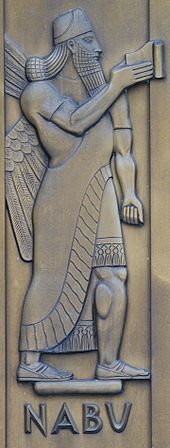Nabu
This article needs additional citations for verification. (November 2015) |

| Nabū | |
|---|---|
 Statue of the Attendant God from the Temple of Nabu at Nimrud, Mesopotamia on display at the British Museum. | |
| Abode | Borsippa |
| Symbol | Clay tablet and stylus |
| Parents | Marduk and Sarpanitum |
| Consort | Tashmet |
| Part of a series on |
| Ancient Mesopotamian religion |
|---|
 |
|
|
| Part of the myth series on |
| Religions of the ancient Near East |
|---|
| Pre-Islamic Arabian deities |
| Arabian deities of other Semitic origins |
Nabu (Akkadian:𒀭𒀝 Syriac: ܢܒܘ) is the ancient Mesopotamian patron god of literacy, the rational arts, scribes and wisdom.
History
Nabu was worshipped by the Babylonians and the Assyrians.[1] Nabu was known as Nisaba in the Sumerian pantheon and gained prominence among the Babylonians in the 1st millennium BC when he was identified as the son of the god Marduk.[1]
Nabu was worshipped in Babylon's sister city Borsippa, where his statue was moved to Babylon each New Year so that he could pay his respects to his father.[1] Nabu's symbol was a stylus resting on a tablet.[1] Clay tablets with especial calligraphic skill were used as offerings at Nabu's temple. His wife was the Akkadian goddess Tashmet.[1]
Nabu was the patron god of scribes, literacy and wisdom,[1] as well as the inventor of writing, a divine scribe, and the patron of all the rational arts.[2] Due to his role as an oracle, Nabu was associated with the Mesopotamian moon god Sin.[2]
Nabu wore a horned cap, and stood with his hands clasped in the ancient gesture of priesthood.[original research?] He rode on a winged dragon known as Sirrush that originally belonged to his father Marduk.[original research?] In Babylonian astrology, Nabu was identified with the planet Mercury.[citation needed]
Nabu was continuously worshipped until the 2nd century, when cuneiform became a lost art.[1]
Outside Mesopotamia
Nabu's cult spread to ancient Egypt.[citation needed] Nabu was one of five non-Egyptian deities worshipped in Elephantine.[3][failed verification]
In the Bible, Nabu is mentioned as Nebo in Isaiah 46:1 and Jeremiah 48:1.[1][4][5] In Hellenistic times, Nabu was identified, and sometimes syncretized, with the Greek god Apollo.[1]
As the god of literacy and wisdom, Nabu was linked by the Romans with Mercury, and by the Egyptians with Thoth.[citation needed]
Depictions
A statue of Nabu from Nimrud (ancient Kalḫu), erected during the reign of the Assyrian king Tiglath-Pileser III, is on display in the British Museum.[citation needed]
References
- ^ a b c d e f g h i Bertman, Stephen (2005). Handbook to Life in Ancient Mesopotamia (Paperback ed.). Oxford: Oxford University Press. p. 122. ISBN 9780195183641. Retrieved 2016-08-08.
- ^ a b Green, Tamara M. (1992). The City of the Moon God: Religious Traditions of Harran. Leiden: E.J. Brill. p. 33-34. ISBN 9004095136. Retrieved 2017-01-04.
- ^ Schattner-Rieser, Ursula (2008). "La Bibliothèque d'Eléphantine (Egypte)". Tsafon. 56: 13. Retrieved 12 May 2017.
- ^ "Isaiah 46:1 NIV – Gods of Babylon – Bel bows down, Nebo". BibleGateway.com. Retrieved 2015-06-23.
- ^ "Jeremiah 48:1 NIV - A Message About Moab - Concerning Moab". BibleGateway.com. Retrieved 2015-07-02.
External links
- . New International Encyclopedia. 1905.
